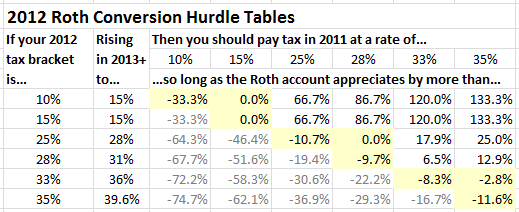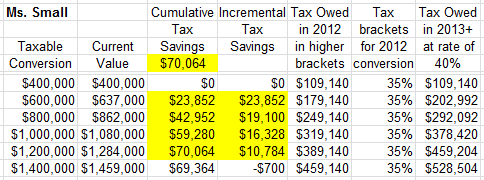In Roth IRA Conversion 2012: A Roth Conversion Calculator I showed how nearly everyone is an excellent candidate for executing a Roth conversion this year. But the exact amount depends on your annual taxable income, age, value of your IRA and how much it appreciates after conversion but before you have to make a decision on how much to keep as a Roth conversion. Because you can always undo part or all of a conversion with a Roth recharacterization, you can’t convert too much.
Here is the calculations for my example of Ms. Small Business Owner:
She has an annual taxable income of $400,000. Her income is at the highest 35% tax rate. Last year she paid about $130,000 in state and federal taxes. She is 50 years old and working to expand her business as her annual income allows. She has built up $1 million in IRA accounts that could be converted.
Ms. Small will probably never be in a lower tax bracket. Her tax rate is scheduled to increase from 35% to 39.6% at the end of 2012. At that higher tax rate, the mortgage on her million-dollar IRA will rise from $350,000 to $395,000. Paying it off early could save her $45,000. In fact, she should keep any amount converted so long as it doesn’t drop by more than 11.6%.
That means that if she converts an extra $100,000 in the 2012 35% tax bracket she will pay $35,000 in taxes come April 2012. Even if the Roth has dropped 11.6% in value by then she might as well keep the Roth rather than recharacterize it and move it back to a traditional IRA. Paying $35,000 on an account which has dropped to $88,400 (-11.6%) is the same as recharacterizing it, waiting 30 days and then reconverting $88,400 at the higher 39.6% tax bracket and paying $35,000 in taxes anyway.
Since Ms. Small’s base salary of $400,000 will put her in the 29.6% tax bracket going forward in 2013 and beyond after the Bush tax cuts expire, we set the hurdle rates based on the assumption that in future years she could continue to convert any amounts recharacterized at this future 39.6% rate. Ms. small is on the 35% rising to 39.6% line of this 2012 Roth Conversion Hurdle Tables:

For you math geeks, the formula for the hurdle calculation is:
HurdlePct = (Marginal2011RateYouAreBeingPushedInto / BaseRateYouAreRisingIntoFor2013+) – 1;
for example, your base salary is $400,000. You are in the 2012 35% bracket and will be rising to the 39.6% 2013+ bracket. You are considering converting as much as possible in the 35% tax bracket. therefore:
HurdlePct = (0.35 / 0.396) – 1 = -0.116 = -11.6%
Each Roth conversion account can be converted and recharacterized separately so long as the accounts are segregated and kept in separate accounts. Keeping separate piles of money in separate accounts when doing a Roth conversion is called a Roth Segregation. Segregating accounts allow any converted account which drops by more than 11.6% to be recharacterized and not spoil the conversion of the other accounts.
Imagine that Ms. Small converts her $1M traditional IRA by creating five different Roth Segregation accounts of $200,000 of initial conversion amount each. Then she might invest each account differently while maintaining a balanced portfolio in aggregate. She might invest one in emerging markets, one in countries with the most economic freedom, a third in US technology, a fourth in US small cap and a fifth in bonds. These different accounts gives a greater chance that one account with poor returns would not spoil the conversion of the other four accounts over the 18 months between the conversion in January of 2012 and the last chance to recharacterize the Roth conversion before you have to file your taxes by the extension deadline in October of 2013.
Here is a table of what amount of the Roth conversion should be kept (in yellow) based on current account values (in tan):

In this example, since Roth #5 has fallen 12.5% it is better to unconvert (recharacterize) it and convert it again next year at the higher 39.6% tax rate. Had it only dropped 11.5% however, it would have been better to keep it.
Given the account values being such that four of the accounts should be kept as Roth conversions, The tax savings in this case is $70,064:

In this table, Ms. Small should keep $800,000 of the $1M Roth conversion, which has now grown to $884,000. Adding the $800,000 onto her $400,000 base income, Ms. Small will pay $389,140 in federal tax in 2012. This is $280,000 in additional taxes over her base salary. Having non-retirement assets to pay the tax is an important qualification to executing a Roth conversion. This is one of the reasons why we recommend every family save 10% of their pay in retirement vehicles, and an additional 5% in a taxable investment account.
Who would have thought that someone earning $400,000 might want to purposefully push their taxable income up to $1.2M this year in order to pay $280,000 more in taxes at these lower 2012 tax rates?
But this type of tax planning makes sense and saves $70,064 in future taxes.
This example is for illustrative purposes only and we do not recommend executing a Roth conversion without the assistance of a fee-only fiduciary financial planner such as a NAPFA member and a professional tax advisor such as an enrolled agent or CPA.
If you have a $1M IRA and are in the top tax bracket, what are you waiting for?
Subscribe to Marotta On Money and receive free access to a hour long Roth IRA Conversion 2012 Seminar: How to put your money where it will never be taxed again.